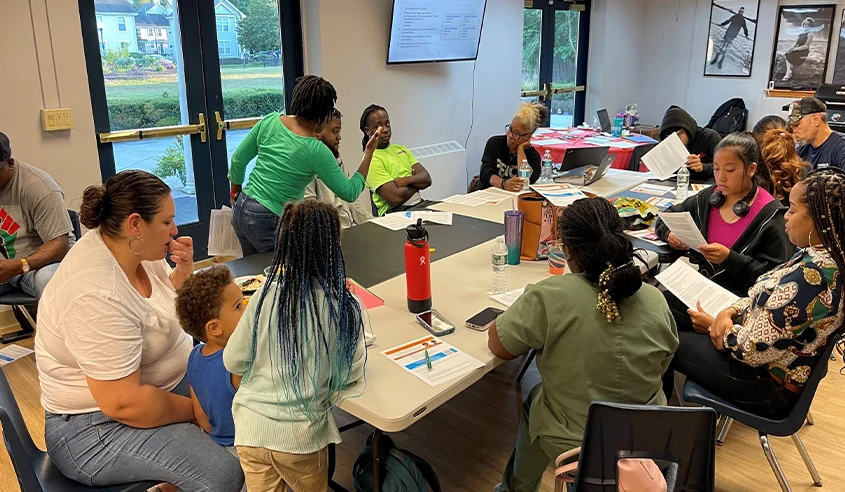ELEVATING THE VOICES OF YOUNG PEOPLE
Prepared by Community ScienceMETHODOLOGY
The research team interviewed 74 young people aged 14–26 who were not connected to school, work, and prosocial supports to learn about the first-hand experiences and perspectives of young people in the cities in Connecticut with the most concentrated amounts of young people experiencing disconnection from school and employment opportunities.
Exhibit 1: Summarizing Our Study
- How youth view themselves and their community
- The kinds of successes/
challenges youth experience - Resources youth consider useful to support progress toward their goals
- Experience living in their specific neighborhood or community
- History with different systems (e.g., education, housing, child welfare)
- Plans and hope for the future (goals and aspirations)
COMMUNITY ADVISORY GROUP
Exhibit 2: Community Advisory Group Composition
- The CAG membership consist of 13 members, 9 Youth & 4 Adults
- Youth age range from 14 to 26
- There are 6 women and 7 men, with a range of racial and ethnic backgrounds
- The 4 adult members worked with the youth community through various youth-serving orginazations:
- Compass Youth Collaborative
- Our Piece of the Pie
- PT Partners
- William Casper Graustein Memorial Fund

Contextualizing Young People’s Experience




Education Attainment of Participants
WEB OF SYSTEMS IMPACTING YOUNG PEOPLE
This section aims to provide an overview of the systems that young people interact with daily, highlighting the workings of the systems and the systems’ collective impact on young people’s ability to survive and thrive in Connecticut.
The Dual Faces of the Education System.
- While education promises advancement, the system requires a holistic approach that uplifts culturally relevant teaching and effectively supports the learning differences of young people.
The Criminal Justice System: A pathway or a roadblock?
- The criminal justice system's role in young people's lives is marked by its potential to rehabilitate or further marginalize by creating barriers for young people to access services.
Child Welfare: A spectrum of support & instability
- The child welfare system embodies the spectrum of being supportive and contributing to instability, with its capacity to either safeguard well-being or contribute to further disconnection.
Healthcare: Bridging Gaps in Well-being
- Accessible, affordable, and culturally responsive healthcare, including mental health services, is fundamental to the well-being and resilience of young people.
Housing: The Foundation of Stability & Opportunity
- Addressing issues around housing instability is paramount for housing to fulfil its role as a foundation of support and reconnection rather than a source of instability.
Education is the system that most participants discussed, followed by criminal justice, which includes direct involvement, such as arrests or interactions, and extends to situations where participants cooperate with law enforcement or act as witnesses, including cases involving their loved ones.
Young People’s Goals & Aspirations: Getting Back on Track
Despite the challenges many young people faced, most shared aspirations and goals and were hopeful about their future. Employment and educational attainment are a means to getting what they ultimately value, such as financial security. Their definitions of success commonly reflected their resilience, resourcefulness, and determination to transcend the limitations imposed upon them by societal norms and structural inequalities.
- Doing Better for their Children Participants, particularly mothers, discussed wanting to do better for their children’s sake, with family unification as a core piece of their aspirations.
- Giving Back to
Others Participants discussed wanting to help others in need or in similar situations, like building a place where young girls could live safely when they do not have other places to go. - Becoming More Financially Stable Participants aspired to find a well-paying job to provide basic needs, such as stable housing, food security, and access to healthcare, for themselves and their families.
- Furthering Their Education Participants talked about returning to school, whether a community college, university, or trade school. Others discussed going back to high school or getting a GED.
- Seeking Support
Services Young people sought to connect to or further connect to support services, such as youth-serving nonprofit agencies, support and therapy groups, and church or religious groups. - Wanting to Move to Another Place “Making it out” commonly represented attaining a level of stability and security that allowed them to break free from the constraints of their circumstances and chart their own path toward a brighter future.
Opportunities to Build Connection Over Disconnection
By addressing the root causes of disconnection and amplifying opportunities for empowerment, Connecticut can unlock the potential of all young people to thrive academically, economically, and socially.
- Education: Restorative practices, trauma-informed approaches, and wraparound services can enhance the capacity of schools to address the complex needs of marginalized youth and mitigate the risk of disconnection.
- Housing: The challenges and effects of housing instability ranged from young people grappling with frequent moves, relying on informal housing arrangements, and in other cases, homelessness.
- Health: By recognizing the importance of comprehensive mental health support services and prioritizing culturally responsive mental healthcare, Connecticut can mitigate the long-term effects of trauma and support holistic well-being of young people.
- Criminal Justice: Addressing systemic racial biases, promoting equitable treatment, and prioritizing rehabilitation over punitive measures are essential for Connecticut to create and promote supportive pathways for young people.
- Child Welfare: By investing in family-centered interventions, programs, and support services, Connecticut can create more stable and supportive environments for young people, ultimately, reducing their involvement in systems.
What CTOP Is Doing
CTOP invests in non-profit organizations in Connecticut working with young people who are severely off-track and disconnected. Through long-term partnerships, we provide financial and non-financial resources, supporting our grantee partners in strenghtening their organizational capacity and ability to consistently deliver positive, long-term outcomes for young people.
